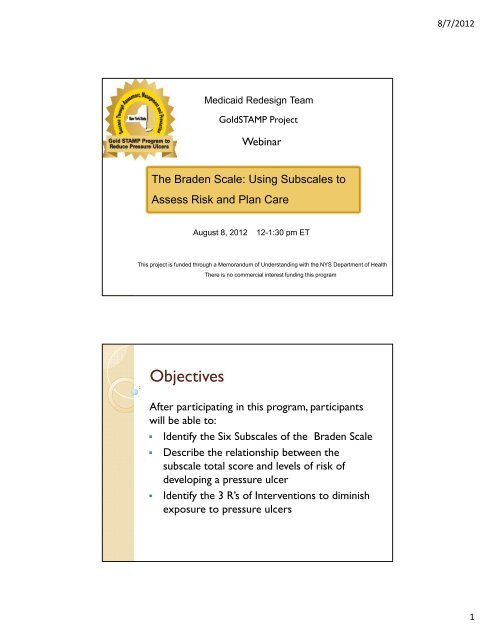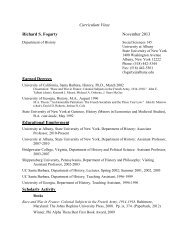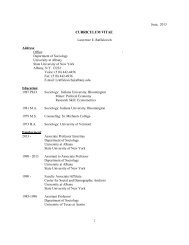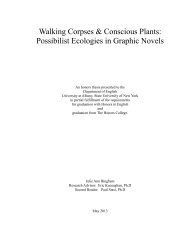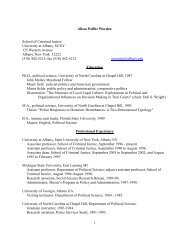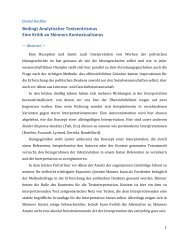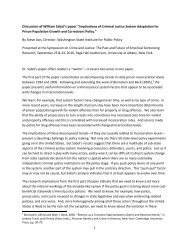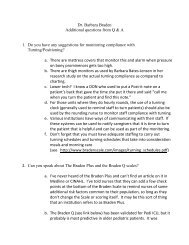Handouts
Handouts
Handouts
You also want an ePaper? Increase the reach of your titles
YUMPU automatically turns print PDFs into web optimized ePapers that Google loves.
The Braden Scale: Using Subscales to<br />
Assess Risk and Plan Care<br />
August 8, 2012 12-1:30 pm ET<br />
This project is funded through a Memorandum of Understanding with the NYS Department of Health<br />
There is no commercial interest funding this program<br />
Objectives<br />
Medicaid Redesign Team<br />
GoldSTAMP Project<br />
Webinar<br />
After participating in this program, participants<br />
will be able to:<br />
Identify the Six Subscales of the Braden Scale<br />
Describe the relationship between the<br />
subscale total score and levels of risk of<br />
developing a pressure ulcer<br />
Identify the 3 R’s of Interventions to diminish<br />
exposure to pressure ulcers<br />
8/7/2012<br />
1
The Braden Scale<br />
Using Subscale Scores to<br />
Assess Risk and Plan Care<br />
LEVELS OF PRESSURE SORE RISK USING<br />
BRADEN SCALE<br />
MILD RISK 15-18<br />
MODERATE RISK 13-14<br />
HIGH RISK 10-12<br />
VERY HIGH RISK < 9<br />
8/7/2012<br />
2
Predictive Value of Positive Result (PVP)<br />
(TP/TP+FP) across a range of scores<br />
Levels of Risk Score Ranges Approximate PVP<br />
Mild Risk 15-18 30-60%<br />
Moderate Risk 13-14 50-75%<br />
High Risk 10-12 60-90%<br />
Very High Risk 9 and below 100%<br />
Figure 1<br />
All At-Risk Patients Are Not Created<br />
Equal: Analysis of Braden Pressure<br />
Ulcer Risk Scores to Identify Specific<br />
Risks<br />
Tescher, Ann N.; Branda, Megan E.; Byrne,<br />
T. J. O; Naessens, James M.<br />
Journal of Wound Ostomy & Continence<br />
Nursing. 39(3):282-291, May/June 2012.<br />
doi: 10.1097/WON.0b013e3182435715<br />
FIGURE 1. Braden Scale score values.<br />
aPercentages represent the percent of<br />
patients with the given score that<br />
developed a pressure ulcer.<br />
Copyright © 2012 Journal of Wound Ostomy & Continence Nursing. Published by Lippincott Williams & Wilkins. 12<br />
8/7/2012<br />
3
Both Cases Braden Scale = 12<br />
Which case is probably a True positive and which<br />
is probably a False positive?<br />
24 yr old male<br />
Appears healthy, wellnourished<br />
Hernia repair<br />
Immediate post-op Braden<br />
Scale score =12<br />
Both Cases Braden Scale = 21<br />
60 yr old male<br />
500 lbs (272.3 kg)<br />
Hypoventilation syndrome<br />
Low PO 2<br />
CHF, edema, low BP<br />
Somnolent<br />
Admission Braden Scale<br />
score = 12<br />
Which is Probably a True negative and which is<br />
probably a False negative?<br />
70 yr old male<br />
Appears healthy and but<br />
overweight<br />
Diabetic with arterial<br />
insufficiency, peripheral<br />
neuropathy and hx of<br />
diabetic ulcers<br />
Admitted for laparoscopic<br />
cholecystectomy<br />
Pre-op Braden Scale score<br />
= 21<br />
30 yr old male<br />
marathon runner<br />
Appears healthy but very<br />
thin<br />
Admitted for arthroscopy<br />
Pre-op Braden Scale score<br />
= 21<br />
8/7/2012<br />
4
Risk Assessment<br />
+<br />
Consideration of Individual Factors<br />
+<br />
Clinical Judgment<br />
=<br />
Better Prediction and Better Prevention<br />
Subscales as predictors<br />
Lahmann & Kottner. Relation between pressure, friction and pressure ulcer categories: a secondary<br />
analysis of hospital patients using CHAID methods. International Journal of International Studies. 48<br />
(2011) 1148-1494<br />
Settings:161 hospitals, all specialties and categories throughout Germany<br />
Subjects: 28,299 adult patients, average 65.4 and 55% female.<br />
Methods: controlling for age, subscales were entered into a special statistical<br />
method (Chi-square automatic interaction detection) to determine which<br />
subscales were predictive of superficial pressure ulcers and which were<br />
predictive of full-thickness ulcers (Stage III and IV).<br />
Friction and Shear was the strongest predictor of Stage II ulcers<br />
The mobility subscale score of 1 (completely immobile) was the strongest<br />
predictor of Stage III and IV ulcers<br />
8/7/2012<br />
5
Tescher, Branda, O’Byrne, Naessens. All at-risk patients are not created equal:<br />
Analysis of Braden Pressure Ulcer Risk Scores to identiy specific risks.<br />
JWOCN. May/June 2012, 39(3) 1-10<br />
Subjects and setting:<br />
◦ 12566 adult patients in ICU or progressive care units within Mayo Clinic with<br />
scores of 18 or less<br />
◦ 416 patients with HAPU stage 2-4 were studied<br />
Friction and shear subscale had the greatest predictive power<br />
Interesting interactions were noted<br />
◦ Patients scoring 1 on both activity and moisture had a 57% increase in<br />
risk (as compared to patients with a score of 1 on only one of those<br />
subscales.<br />
◦ Patients who scored the lowest (1) on both mobility and sensory<br />
perception subscales had a 67% increase in risk as compared to those<br />
with 1 on mobility but a higher sensory perception subscale score.<br />
Risk Assessment as Clinical Data<br />
Each subscale score serves as<br />
◦ an initial appraisal of patient’s specific problems and functional<br />
deficits<br />
◦ A flag for assessments that need to be explored further<br />
◦ A guide to the types of interventions that should be used<br />
Total scores and levels of risk serve as<br />
◦ An estimate of the probability that a pressure ulcer will occur<br />
◦ A guide to the intensity of the interventions that should be used.<br />
8/7/2012<br />
6
PLANNING CARE BY<br />
RISK FACTORS<br />
Interventions from NPUAP –EPUAP Guidelines will<br />
be indicated with a green asterisk<br />
Sensory Perception<br />
Level Of Consciouness<br />
◦ Carefully assess ability to move in bed and supplement any<br />
deficit<br />
◦ If sensory perception is a 1 and mobility is a 1, the patient is<br />
profoundly immobile and an active powered surface is likely<br />
to be necessary<br />
Cutaneous Sensation<br />
◦ Protect all bony prominences that are affected by sensory<br />
deficits<br />
8/7/2012<br />
7
Activity<br />
If patient can ambulate with assistance, be certain to plan<br />
carefully for assistance<br />
If patient is chairfast, provide good positioning, good<br />
support surface and frequent repositioning in the plan.<br />
For Chairfast or Bedfast Patients, examine mobility within<br />
that environment closely<br />
Mobility<br />
As mobility scores decrease, your concern about the<br />
adequacy of the support surface should increase<br />
As mobility scores decrease, your concern about<br />
repositioning<br />
The less the patient moves, the more the bed should<br />
move for them.<br />
At lowest scores, use active powered surface, 30 degree<br />
rule and supplement with small shifts<br />
8/7/2012<br />
8
Managing Moisture<br />
Use commercial moisture barrier<br />
Use absorbent pads or diapers that wick and hold moisture<br />
Address cause if possible<br />
Do prompted voiding and hydration in conjunction with turning<br />
schedules<br />
Manage tube feedings appropriately<br />
Nutrition<br />
Screen and assess the nutritional status of every<br />
patient at risk<br />
Refer each patient with nutritional risk and pressure<br />
ulcer risk to nutritionist and other health care<br />
professionals as appropriate<br />
Minimally offer 30-35 kcal per kg of body weight per<br />
day and 1.23-1.5 g/kg/day and 1 ml of fluid per kcal per<br />
day<br />
8/7/2012<br />
9
Specific Nutritional Interventions<br />
For those at risk who have special needs<br />
that make it difficult to meet their<br />
nutritional needs with ordinary oral<br />
intake, high protein mixed oral or enteral<br />
supplementation should be provided in<br />
addition to usual diet<br />
Administer between meals to avoid<br />
interfering with normal appetite<br />
Managing Friction & Shear<br />
HOB Elevated No More Than 30 Degrees<br />
After moving from flat to elevated positioning, roll<br />
sideways to release shear forces.<br />
Use Trapeze When Indicated for Self-Care<br />
Use Lifting aids To Move Patient<br />
Protect Elbows & Heels If Being Exposed To Friction<br />
Some recent QA studies found use of silicone coated<br />
dressings or silicone skin creams can decrease incidence<br />
of ulcers, but RCT found no difference.<br />
8/7/2012<br />
10
Conceptual Schema for Etiologic<br />
Factors in Pressure Sore Development<br />
Intensity & Duration<br />
of Pressure<br />
Pressure Sore<br />
Development<br />
Tissue Tolerance<br />
3 R’s<br />
Redistribution Surfaces*<br />
◦ Reactive<br />
◦ Active<br />
◦ Non-powered<br />
◦ Powered<br />
Remobilization<br />
Repositioning<br />
Mobility<br />
Activity<br />
Sensory Perception<br />
Extrinsic Factors<br />
Moisture<br />
Friction & Shear<br />
Intrinsic Factors<br />
Nutrition<br />
Aging<br />
Low arteriolar pressure<br />
Low oxygen tension<br />
INTERVENTIONS TO DIMINISH<br />
EXPOSURE TO PRESSURE<br />
*See www.npuap.org - click on Research- then on Support Surface Standards Initiative<br />
8/7/2012<br />
11
Systematic Review and Meta-Analysis of<br />
Pressure Relieving Surfaces<br />
McGinnes, et.al . Support surfaces for pressure<br />
ulcer prevention. Cochrane Database Syst. Rev.<br />
2008, Issue 4:1-95<br />
Summary of Meta-Analysis<br />
52 randomized clinical trials<br />
Covering total population of 10,000 patients<br />
Findings<br />
◦ Advanced surfaces can reduce the development of<br />
pressure ulcer relative to standard foam<br />
mattresses by over 60%<br />
◦ Alternating pressure mattresses provide greatest<br />
reduction in risk<br />
8/7/2012<br />
12
Support Surfaces in Patients at Risk<br />
Use higher specification foam than standard<br />
Use an active surface for patients at higher risk<br />
Alternating pressure active support overlays and<br />
mattresses have similar efficacy.<br />
Do not use small cell alternating air mattresses or<br />
overlays<br />
Continue to turn and reposition<br />
Other Support Surfaces in<br />
Prevention<br />
Avoid use of synthetic sheepskin pads,<br />
cutouts, rings, donut – type devices or<br />
water-filled gloves<br />
If sheepskin is used, it should be a natural<br />
sheepskin<br />
8/7/2012<br />
13
Repositioning<br />
In persons at risk, repositioning should be<br />
undertaken<br />
Repositioning use and frequency should<br />
be influenced by individual risk factors<br />
and the support surface being used<br />
Repositioning Technique<br />
Avoid positions that cause excess pressure<br />
(side-lying, semi-recumbent) and use positions<br />
that minimize pressure and shear (30 degree<br />
lateral and HOB elevation)<br />
Use transfer aids to avoid friction and shear<br />
Avoid positioning on bony prominences with<br />
signs of skin damage<br />
8/7/2012<br />
14
Mimura, et al (2009)<br />
In a series of positions with interface pressure<br />
measurements:<br />
◦ Found that raising the knees 20 degrees shifted body weight to<br />
the posterior side of the thigh, thus lowering pressure and shear<br />
at the coccyx.<br />
◦ Concluded that the knees should be raised before the head of<br />
the bed is raised.<br />
◦ it was also recommended that the patients be turned to their<br />
side briefly, to release the surface pressure and shear forces.<br />
Peterson, et al (2008)<br />
Used 15 healthy volunteers to study the effects of HOB<br />
elevations of 0, 10, 20 30, 45, 60 and 75 degrees.<br />
◦ Found that elevations of 30 degrees and higher caused peak<br />
interface pressures that were significantly greater than those<br />
experienced in the supine position.<br />
◦ The lowest sacral pressures occurred in the 0 degree elevation<br />
with only slight increases in sacral pressure at 10 and 20 degrees.<br />
8/7/2012<br />
15
Conclusions for Supine Positioning<br />
Safest supine position, for those patients who can tolerate it,<br />
is with a HOB elevation from 0 to 20 degrees.<br />
When the nurse plans to elevate the head of the bed, the<br />
knees should first be elevated in the range of 20 to 30<br />
degrees, according to patient condition, comfort and<br />
preference.<br />
When the goals of care include both prevention of pressure<br />
ulcers and prevention of ventilator associated pneumonia, an<br />
acceptable elevation for the HOB is most likely right at 30<br />
degrees.<br />
Protecting the Heels in the Supine Position<br />
The calf should be supported and the heels<br />
“floated” so they are not in contact with the<br />
surface of the bed and care should be taken to<br />
avoid pressure on the Achilles tendon.<br />
The knee should be in slight flexion to avoid<br />
obstruction of the popliteal vein.<br />
8/7/2012<br />
16
Any particular device for heel<br />
elevation?<br />
◦ Junkin and Gray.Journal of Wound, Ostomy & Continence<br />
Nursing, 2009 Nov-Dec; 36 (6): 602-8<br />
systematic review of methods for preventing heel<br />
ulcers<br />
outlined a variety of issues with each of these studies<br />
concluded that there was insufficient evidence determine which<br />
surface or heel protection device should be used in clinical<br />
practice.<br />
90 ◦ lateral vs 30 ◦ lateral<br />
Colin, et al (1996) using 20<br />
healthy subjects<br />
• compared the effects of 90 degree<br />
and 30 degree laterally inclined<br />
positions in TcP02 and TcCO2 • demonstrated a “dramatic<br />
impairment oxygen supply” in these<br />
areas when the subjects were<br />
positioned in the 90 degree lateral<br />
position but not in the 30 degree<br />
lateral position.<br />
Moore, Cowan and Conroy, 2011<br />
8/7/2012<br />
17
Lateral Positioning and<br />
Clinical Reality<br />
Without careful positioning, patients do not tolerate this<br />
position well.<br />
Patients in studies of lateral positioning often<br />
spontaneously repositioned themselves<br />
Patients who can spontaneously reposition themselves<br />
should be put in the lateral position that is most<br />
comfortable to them<br />
This position is most important and better tolerated by<br />
those who are obtunded or in deep coma.<br />
Repositioning/Turning<br />
HIGH RISK –<br />
◦ Q2h turning schedule<br />
Very High Risk<br />
◦ Supplement with small shifts<br />
41<br />
8/7/2012<br />
18
Pressure Reduction Seating<br />
Systematic review show no clear superiority of<br />
one over another, but need remains<br />
Individualization is important, particularly for<br />
those who are chairfast for all activities of daily<br />
living.<br />
Frequent repositioning or teach selfrepositioning<br />
Lift-offs and Weight Shifting<br />
Supported primarily by the<br />
opinion of clinical experts<br />
Coggrave and Rose (2003)<br />
studied 48 spinal cord injured<br />
patients and found it took<br />
nearly two minutes of pressure<br />
relief for reperfusion to take<br />
place.<br />
Sprigle & Sonenblum, 2011<br />
8/7/2012<br />
19
Repositioning Seated Patients<br />
Position so as to maintain full range of activities<br />
Minimize pressure and shear<br />
Use footstool or footrest when feet do not<br />
touch the floor<br />
Limit time in chair without pressure relief<br />
Give special attention to those with sensory<br />
perception deficits<br />
Chair Positioning<br />
(from Defloor & Grypdonck. [2000] West J Nurs Res,22:335-50)<br />
Best position<br />
Sitting back, legs on rest,<br />
heels suspended<br />
Acceptable position<br />
Sitting up, feet on floor, arms<br />
on rest<br />
8/7/2012<br />
20
Bottom Line<br />
Most pressure ulcers can<br />
be prevented<br />
Requires skin and risk assessment<br />
AND interventions based on risk assessment<br />
Requires consistent care and critical thinking<br />
Requires constant vigilance and continuous quality<br />
improvement<br />
Requires team work and commitment<br />
Above All, It Requires Perseverance<br />
Perseverance is not a<br />
long race;<br />
it is many short races<br />
one after another.<br />
Walter Elliott<br />
The Spiritual Life<br />
8/7/2012<br />
21
QUESTIONS???<br />
NYSDOH Office of Health Systems Management<br />
Jackie Pappalardi, Director, Nursing Home and ICF<br />
Surveillance<br />
Ana Winans, Assistant Director, Bureau of<br />
Credentialing Division of Residential Services<br />
George A Stathidis<br />
www.nysdoh.gov<br />
8/7/2012<br />
22
Linda Laudato BSN, RN Gold STAMP Coordinator<br />
518-402-0330<br />
info@coned.albany.edu<br />
Cheryl Reeves, Director<br />
Judy Bailey, RN Coach/Facilitator<br />
Barbara Bates, RN Coach/Facilitator<br />
www.albany.edu/cphce/goldstamp.shtml<br />
8/7/2012<br />
23


